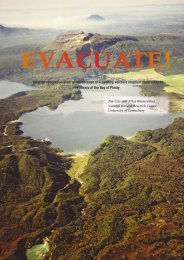Volcanoes - Ministry of Civil Defence and Emergency Management
Volcanoes - Ministry of Civil Defence and Emergency Management
Volcanoes - Ministry of Civil Defence and Emergency Management
You also want an ePaper? Increase the reach of your titles
YUMPU automatically turns print PDFs into web optimized ePapers that Google loves.
THE HIGHLY DISABLED LIVING IN THE COMMUNITY<br />
With regards to the movement <strong>of</strong> people who<br />
have disabilities, the problem was highlighted to us<br />
during our public hearing into the development <strong>of</strong><br />
the Plan. A representation was tabled <strong>and</strong> discussed<br />
to provide for those with high disability who were<br />
living at home. A very good submission was put<br />
forward to include those in the community who<br />
were: totally reliant on others to feed <strong>and</strong> toilet<br />
them; unable to move without assistance; bedridden;<br />
<strong>and</strong> reliant on machines to keep them alive.<br />
The presenters requested that there must be<br />
a register set up <strong>and</strong> maintained, <strong>of</strong> people living at<br />
home with high needs as outlined. Those reliant<br />
on life support equipment such as ventilators are<br />
at risk when the power is cut. St<strong>and</strong>by batteries<br />
only have a short life (ranging from 6-8-10-12<br />
hours) <strong>and</strong> contingencies will need to be in place for<br />
replacement batteries once the st<strong>and</strong>by batteries have<br />
run down. A further example <strong>of</strong> the plight <strong>of</strong> those<br />
disabled living in the community is that they have<br />
the use <strong>of</strong> touch or voice activation mechanisms to<br />
open doors, <strong>and</strong> activate equipment – again these<br />
require electricity <strong>and</strong> any power cut could have<br />
tragic consequences. As we dwell on the logistics <strong>of</strong><br />
shifting those living in the community with a high<br />
level <strong>of</strong> disability we can see that it is a logistical<br />
challenge in itself. It is our task to factor this into<br />
any evacuation plan we have. Therefore good liaison<br />
with community health service providers <strong>and</strong> the<br />
Accident Compensation Corporation is essential, as<br />
well as a regularly updated register. Privacy issues,<br />
while respected, would need to have a commonsense<br />
approach for the desired end result in an emergency.<br />
EVACUATION PLANNING<br />
Evacuation Planning must, as highlighted in the<br />
1996 Science Report:<br />
• Designate the lead agency that will issue the<br />
evacuation order.<br />
• Designate the agencies that will play supporting <strong>and</strong><br />
receiving roles.<br />
• Outline the roles <strong>and</strong> responsibilities <strong>of</strong> all the<br />
agencies involved.<br />
• Identify the potentially dangerous zones to which<br />
or through which the population should not be<br />
evacuated.<br />
• Identify the preferred evacuation routes <strong>and</strong> ways to<br />
keep them open under eruption conditions.<br />
• Identify assembly points for persons who require<br />
transport for evacuation <strong>and</strong> public information<br />
pertaining to these.<br />
Taupo Volcanic Zone<br />
• Consider the means <strong>of</strong> transport, traffic control,<br />
assistance <strong>and</strong> direction.<br />
• Identify potential shelters <strong>and</strong> accommodation in<br />
refuge zones.<br />
We now must make realistic plans which<br />
will efficiently <strong>and</strong> safely convey those from danger<br />
to staging points for relocation. There are several<br />
strategically located Race Courses within the Bay <strong>of</strong><br />
Plenty <strong>and</strong> in neighbouring regions which would serve<br />
adequately as short term accommodation <strong>and</strong> staging<br />
points.<br />
Let’s explore the implications. The Operations<br />
Working Party will be tasked with developing an<br />
Evacuation Plan, which will not only cater for volcanic<br />
eruptions, but for the other hazards we have within the<br />
boundaries <strong>of</strong> our region. These hazards will include<br />
tsunami <strong>and</strong> earthquakes. Through widely involving<br />
our networks <strong>and</strong> following the founding principles <strong>of</strong><br />
evacuation we will have a robust evacuation plan, which<br />
will be flexible enough to cater for all contingencies <strong>and</strong><br />
give a foundation to those having to implement it.<br />
While we are discussing the implications <strong>of</strong> a<br />
volcanic eruption we need to discuss the location <strong>of</strong><br />
EOC’s (<strong>Emergency</strong> Operations Centres). In arriving at<br />
this decision we must be mindful <strong>of</strong> the fact that in our<br />
region we can easily be isolated <strong>and</strong> divided from within<br />
through natural <strong>and</strong> man-made hazards following an<br />
eruption. Therefore we must be careful not to put<br />
all our eggs in one basket by going for a central EOC<br />
catering for all Districts within the Region. Experience<br />
<strong>and</strong> a need for balance suggests that EOC’s should<br />
be strategically located within a District or shared by<br />
56<br />
TEPHRA<br />
June 2004

















